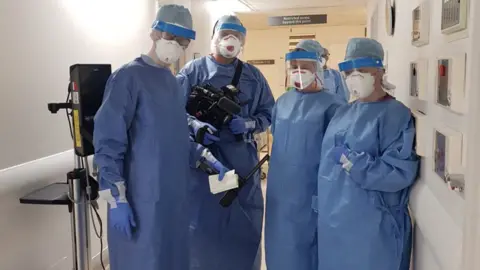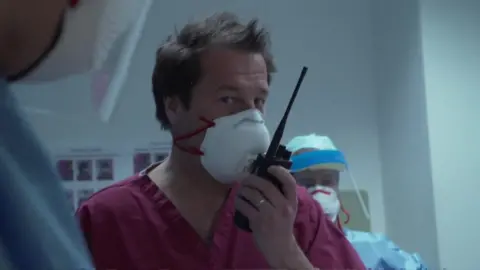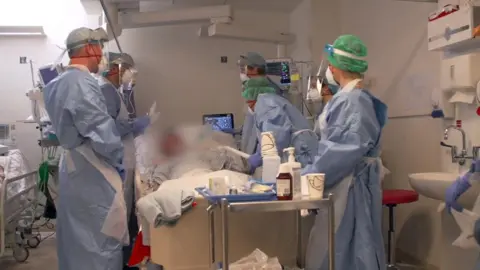The battle against a vicious disease
 BBC
BBCStay at home; protect the NHS; save lives.
We have all heard it so often in recent weeks. But with the weather improving and Easter coming, many will be tempted to bend the guidance a little.
A few hours in an intensive care unit, though, would end any lingering doubts social distancing is not really that important.
With cameraman Adam Walker, I spent a day with medical staff at University College Hospital, the huge teaching hospital that looms over the Euston underpass, in central London.
It was a sobering, even harrowing experience.
I have said many times coronavirus causes a mild illness for most. And that is still true.
But such is the spread of the virus, the minority who fall seriously ill is ever-growing.
And many of them end up in intensive care.
Transformed care
University College London Hospitals NHS Trust, like others around the country, has completely reconfigured its care.
In normal times, University College Hospital has 680 beds, 35 of those for patients needing critical care.
Now, almost 350 general beds are being set aside for Covid-19 patients.
Ward after ward that would usually have dealt with patients with other conditions have now become what are referred to as Covid wards.
In the past few days, extra internal doors have been put on some wards, to increase infection control.
And the 35 ICU beds have been more than doubled, to 86, by converting 10 operating theatres and recovery areas.
Some 150 high-dependency beds, where patients can receive non-invasive ventilations, have also been created.
It is a massive expansion and there are plans, if needed, to increase the total to 250 beds for the sickest patients.
Put simply, the hospital has been transformed into what is mostly a coronavirus care centre, with a great emphasis on treating the sickest patients.
Laborious routine
Everyone working in intensive care must wear full personal protective equipment (PPE).
This includes a tight-fitting face mask, visor, surgical gown and two sets of gloves.
The putting on and taking off of PPE is laborious and must be done every time staff enter or leave ICU.
This donning and doffing, as it's called, is done several times a day because staff are advised to take a break every two hours.
Little wonder they are getting through so much - and need so much more.

Wearing the kit is stifling - but you can't have a drink of water until your time on the ICU is finished.
Staff write their name in marker pen on their aprons, so they can be quickly identified under their visor and respirator.
They have become expert at using hand-signals, as voices are muffled by the face masks and visor.
And walkie-talkies are used to communicate with staff outside ICU, because the PPE means you can't use a telephone.
Incredible teamwork
The teamwork in intensive care is hugely impressive, with doctors and nurses working as one.
They have bonded like never before, supporting each other in the face of the biggest crisis ever faced by the NHS.
They put their faith in the protective layers they wear and the strict infection protocols they follow.
But they know the risk of infection is ever present and several NHS medical staff have died with Covid-19.

- A SIMPLE GUIDE: How do I protect myself?
- AVOIDING CONTACT: The rules on self-isolation and exercise
- LOOK-UP TOOL: Check cases in your area
- MAPS AND CHARTS: Visual guide to the outbreak
- VIDEO: The 20-second hand wash

The staff worry about the patients, each other, and the impact on their families.
In normal times, the area where we did most of our filming is used for recovery.
Patients spend a couple of hours there after surgery, before returning to a general ward.
Now, it has been converted into an intensive unit, treating many of the sickest patients.
Daunting equipment
A huge array of equipment surrounds each bed.
Most crucial are the sophisticated ventilators, which take over the patient's breathing.
There are monitors checking the patient's vital signs and pumps delivering the drugs to keep them heavily sedated.

In the most serious cases, the patient's immune system goes haywire and starts attacking the body as well as the virus.
Inflammation can lead to multi-organ failure.
Patients are also at risk of secondary bacterial infections.
Although trials are under way, there is no proven drug to treat coronavirus.
The treatment is oxygen and organ support.
Patients may need many days on a ventilator to give their lungs time to slowly recover.
But this is a vicious disease and many do not make it.
I must end by expressing my sincere thanks to all the staff at University College London Hospitals NHS Foundation Trust.
They felt it was crucial the public saw what coronavirus can do - and how the NHS has responded.
They are doing their utmost in this war against coronavirus.
But each of us has a part to play in slowing the spread of the virus and ensuring intensive care units can continue to cope.
